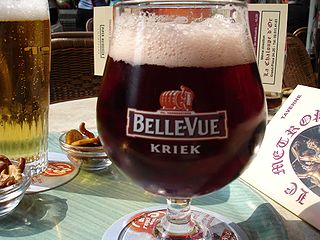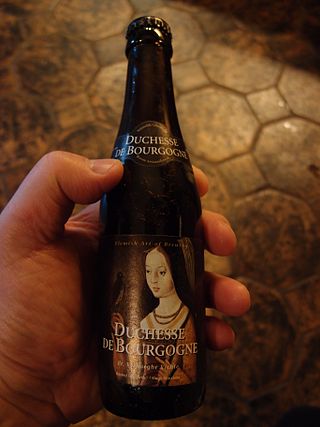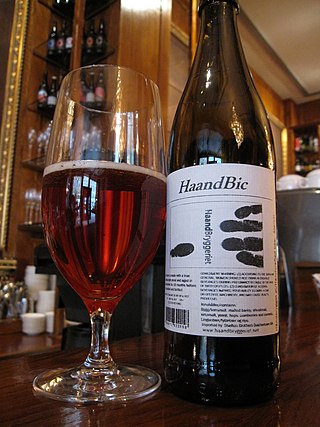
Beer is an alcoholic beverage produced by the brewing and fermentation of starches from cereal grains—most commonly malted barley, although wheat, maize (corn), rice, and oats are also used. The fermentation of the starch sugars in the wort produces ethanol and carbonation in the beer. Beer is one of the oldest alcoholic drinks in the world, the most widely consumed, and the third most popular drink after water and tea. Most modern beer is brewed with hops, which add bitterness and other flavours and act as a natural preservative and stabilising agent. Other flavouring agents, such as gruit, herbs, or fruits, may be included or used instead of hops. In commercial brewing, natural carbonation is often replaced with forced carbonation.

Kriek lambic is a style of Belgian beer, made by fermenting lambic with sour Morello cherries. Traditionally "Schaarbeekse krieken" from the area around Brussels are used. As the Schaarbeek type cherries have become more difficult to find, some brewers have replaced these with other varieties of sour cherries, sometimes imported.

Wheat beer is a top-fermented beer which is brewed with a large proportion of wheat relative to the amount of malted barley. The two main varieties are German Weizenbier and Belgian witbier; other types include Lambic, Berliner Weisse, and Gose.

Brown ale is a style of beer with a dark amber or brown colour. The term was first used by London brewers in the late 17th century to describe a lightly hopped ale brewed from 100% brown malt.
Berliner Weisse is a cloudy, sour beer of around 3.5% alcohol by volume. It is a regional variation of the wheat beer style from Northern Germany, dating back to at least the 16th century. It can be made from combinations of malted barley and wheat, with the stipulation that the malts are kilned at very low temperatures or even air-dried to minimise colour formation. The fermentation takes place with a mixture of yeast and lactic acid bacteria, a prerequisite that creates the lactic acid taste, a distinguishing feature of Berliner Weisse.

Brettanomyces is a non-spore forming genus of yeast in the family Saccharomycetaceae, and is often colloquially referred to as "Brett". The genus name Dekkera is used interchangeably with Brettanomyces, as it describes the teleomorph or spore forming form of the yeast, but is considered deprecated under the one fungus, one name change. The cellular morphology of the yeast can vary from ovoid to long "sausage" shaped cells. The yeast is acidogenic, and when grown on glucose rich media under aerobic conditions, produces large amounts of acetic acid. Brettanomyces is important to both the brewing and wine industries due to the sensory compounds it produces.

Rodenbach is a brewery in Roeselare, Belgium, now owned by Palm Breweries. It is noted for its barrel-aged sour beers in the Flemish red style.

Beer in Belgium includes pale ales, lambics, Flemish red ales, sour brown ales, strong ales and stouts. In 2018, there were 304 breweries in Belgium, including international companies, such as AB InBev, and traditional breweries, such as Trappist monasteries. On average, Belgians drink 68 litres of beer each year, down from around 200 each year in 1900. Most beers are bought or served in bottles, rather than cans, and almost every beer has its own branded, sometimes uniquely shaped, glass. In 2016, UNESCO inscribed Belgian beer culture on their list of the intangible cultural heritage of humanity.

Beer has been brewed in England for thousands of years. As a beer brewing country, it is known for top fermented cask beer which finishes maturing in the cellar of the pub rather than at the brewery and is served with only natural carbonation.
The term dubbel is a Belgian Trappist beer naming convention. The origin of the dubbel was a strong version of a brown beer brewed in Westmalle Abbey in 1856, which is known to have been on sale to the public by June 1861. In 1926, the recipe was changed by brewer Henrik Verlinden, and it was sold as Dubbel Bruin. Following World War Two, abbey beers became popular in Belgium and the name "dubbel" was used by several breweries for commercial purposes.

Gueuze is a type of lambic, a Belgian beer. It is made by blending young (1-year-old) and old lambics, which is bottled for a second fermentation. Because the young lambics are not fully fermented, the blended beer contains fermentable sugars, which allow a second fermentation to occur.

Oud Bruin, also known as Flanders Brown, is a style of beer originating from the Flemish region of Belgium. The Dutch name refers to the long aging process, up to a year. It undergoes a secondary fermentation, which takes several weeks to a month, and is followed by bottle aging for several more months. The extended aging allows residual yeast and bacteria to develop a sour flavor characteristic for this style. Usually, cultured yeast and bacteria are used, as stainless steel equipment does not harbor wild organisms as wood does.

Brettanomyces bruxellensis is a yeast associated with the Senne valley near Brussels, Belgium. Despite its Latin species name, B. bruxellensis is found all over the globe. In the wild, it is often found on the skins of fruit.

Mash ingredients, mash bill, mashbill, or grain bill are the materials that brewers use to produce the wort that they then ferment into alcohol. Mashing is the act of creating and extracting fermentable and non-fermentable sugars and flavor components from grain by steeping it in hot water, and then letting it rest at specific temperature ranges to activate naturally occurring enzymes in the grain that convert starches to sugars. The sugars separate from the mash ingredients, and then yeast in the brewing process converts them to alcohol and other fermentation products.

Duchesse de Bourgogne is a Flanders red ale-style beer produced by Brouwerij Verhaeghe in Vichte, Belgium. After a primary and secondary fermentation, this ale is matured in oak barrels for 18 months. The final product is a blend of a younger 8-month-old beer with an 18-month-old beer, it has an alcohol percentage of 6.2%.
Beer is produced through steeping a sugar source in water and then fermenting with yeast. Brewing has taken place since around the 6th millennium BC, and archeological evidence suggests that this technique was used in ancient Egypt. Descriptions of various beer recipes can be found in Sumerian writings, some of the oldest known writing of any sort. Brewing is done in a brewery by a brewer, and the brewing industry is part of most western economies. In 19th century Britain, technological discoveries and improvements such as Burtonisation and the Burton Union system significantly changed beer brewing.

Brewery Verhaeghe established in 1875, is a small brewery located in Vichte, West Flanders, Belgium.

Sour beer is beer which has an intentionally acidic, tart, or sour taste. Sour beer styles include Belgian lambics and Flanders red ale and German Gose and Berliner Weisse.

Bourgogne des Flandres is a Belgian beer brewed by Timmermans Brewery in Itterbeek in the municipality of Dilbeek which is located in Flemish Brabant.

A barrel-aged beer is a beer that has been aged for a period of time in a wooden barrel. Typically, these barrels once housed bourbon, whisky, wine, or, to a lesser extent, brandy, sherry, or port. There is a particular tradition of barrel ageing beer in Belgium, notably of lambic beers. The first bourbon barrel-aged beers were produced in the United States in the early 1990s.

















